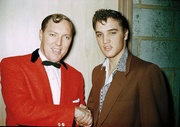
Johnny Cash at Folsom Prison, January 13, 1968. Photo by Jim Marshall via San Francisco Art Exchange.
Photographer Jim Marshall, who grew up in San Francisco’s Fillmore district in the 1940s and ’50s, and passed away in March of 2010, was one of the preeminent chroniclers of the rock, blues, and jazz musicians of 20th century America. Marshall had amazing access, capturing the Beatles during their last performance at Candlestick Park, as well as Janis Joplin backstage at Winterland, a bottle of Southern Comfort in her hand. He attended the best of the 1960s music festivals, from Newport Folk (Joan Baez) to Monterey Pop (Jimi Hendrix) to Woodstock (The Who). And his images were turned into album covers for Jefferson Airplane, the Allman Brothers, and hundreds of others.
One of Marshall’s favorite subjects was Johnny Cash—Marshall’s last book, “Pocket Cash,” devoted entirely to images of the great country singer-songwriter, was published by Chronicle Books shortly after Marshall’s death. To mark the one-year anniversary of that sad event, three galleries are hosting “Pocket Cash” exhibitions during March and April of 2011. They are SNAP Galleries in London, Morrison Hotel Gallery in New York, and San Francisco Art Exchange (SFAE).
“It’s probably the most ripped off photograph in the history of the world.”
Some of Marshall’s most arresting photographs of Cash were taken at two California prisons, Folsom (1968) and San Quentin (1969). These were not Cash’s first performances for prison inmates—indeed, his song “Folsom Prison Blues” had been released more than a decade earlier, in 1955, as a 45 and 78 by Sun Records. But the trip to Folsom would be recorded for a live album, and Jim Marshall was invited along by Cash’s label, Columbia, to document the event.
On the SFAE website, Jim Marshall recalls the day, January 13, 1968, when Cash and his band, the Tennessee Three, with the great Carl Perkins on guitar, entered the prison (see the pensive portrait of Cash, above). “The granite walls in Folsom are about eight feet thick, and we had just gotten off the bus and gone through one giant gate into a holding area. Then we went through a second gate, and, when it clanked shut, John said, ‘Jim, there’s a feeling of permanence in that sound.’ After that, I started wondering when we were going to get out of there.”
The success of “Johnny Cash at Folsom Prison,” with a Marshall close-up of Cash on its cover, sweat dripping down his face from the bottom of his sideburns, sent Cash to San Quentin a year later for another live album. That recording, which made it to No. 1 on both the country and pop charts in the U.S., is famous for its black-and-blue cover, with Cash’s head silhouetted from behind by a harsh spotlight.
The most famous image from the day, though, is unquestionably the candid shot of Cash taken during a rehearsal before the show. Again from the SFAE website, Marshall recalls the origins of what he believed was “probably the most ripped off photograph in the history of the world. There was a TV crew behind me and John was on the side of the stage. I said ‘John, let’s do a shot for the warden.'” Apparently, that’s all the prompting Cash needed to look straight into Marshall’s lens and flip him the bird.
(All photos by Jim Marshall from San Francisco Art Exchange. If you buy something through a link in this article, Collectors Weekly may get a share of the sale. Learn more.)



 Rockin' at the Rollarena, Pre-Summer of Love
Rockin' at the Rollarena, Pre-Summer of Love
 Found Photos: When Rock Lost Its Innocence
Found Photos: When Rock Lost Its Innocence Rockin' at the Rollarena, Pre-Summer of Love
Rockin' at the Rollarena, Pre-Summer of Love Preservation Through Production at Hatch Show Print
Preservation Through Production at Hatch Show Print Country Music RecordsCountry music has as many strains as the Mississippi River has tributaries.…
Country Music RecordsCountry music has as many strains as the Mississippi River has tributaries.… PhotographsFrom Mathew Brady's Civil War photos to Ansel Adams' landscapes to Irving P…
PhotographsFrom Mathew Brady's Civil War photos to Ansel Adams' landscapes to Irving P… Mari Tepper: Laying it on the Line
Mari Tepper: Laying it on the Line Nice Ice: Valerie Hammond on the Genteel Charm of Vintage Canadian Costume Jewelry
Nice Ice: Valerie Hammond on the Genteel Charm of Vintage Canadian Costume Jewelry How Jim Heimann Got Crazy for California Architecture
How Jim Heimann Got Crazy for California Architecture Modernist Man: Jock Peters May Be the Most Influential Architect You've Never Heard Of
Modernist Man: Jock Peters May Be the Most Influential Architect You've Never Heard Of Meet Cute: Were Kokeshi Dolls the Models for Hello Kitty, Pokemon, and Be@rbrick?
Meet Cute: Were Kokeshi Dolls the Models for Hello Kitty, Pokemon, and Be@rbrick? When the King of Comedy Posters Set His Surreal Sights on the World of Rock 'n' Roll
When the King of Comedy Posters Set His Surreal Sights on the World of Rock 'n' Roll How One Artist Makes New Art From Old Coloring Books and Found Photos
How One Artist Makes New Art From Old Coloring Books and Found Photos Say Cheese! How Bad Photography Has Changed Our Definition of Good Pictures
Say Cheese! How Bad Photography Has Changed Our Definition of Good Pictures Middle Earthenware: One Family's Quest to Reclaim Its Place in British Pottery History
Middle Earthenware: One Family's Quest to Reclaim Its Place in British Pottery History Fancy Fowl: How an Evil Sea Captain and a Beloved Queen Made the World Crave KFC
Fancy Fowl: How an Evil Sea Captain and a Beloved Queen Made the World Crave KFC
To further emphasize the impact of Jim’s photos. The Folsom Prison frame historically shows the ethnic change of USA’s prison population.